well this may be a smidgeon slow, but this week has been a tad trying. However you know me, I love a challenge, so lets see how far I can get before I fall asleep on the keyboard and delete the whole lot.
So here we are almost half way through the year, and rocketing towards Christmas. But before that there is lots of time for adventure, or so I hope....
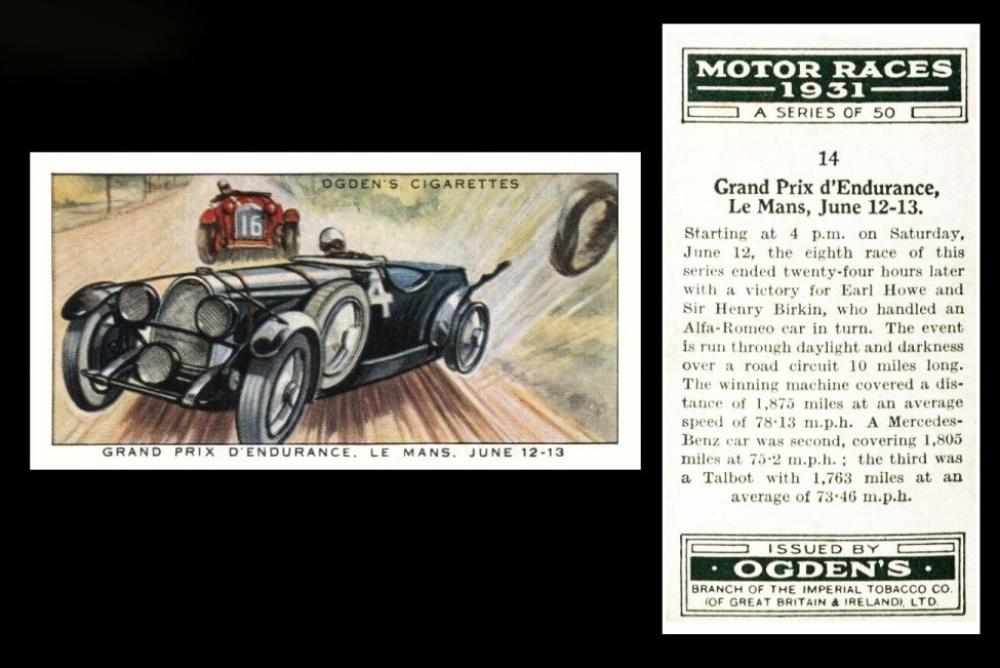
Ogdens [tobacco :UK] "Motor Races 1931" (1932) 14/50 - O100-544 - O/2-161 : O/124 (RB.15/124)
Lets start with one of our centenary diary dates, for today in 1923 saw the cars cross the finish line at Le Mans for the first time.
Our cars shows the ninth race, of the 13th and 14th of June 1931. Bentley was not there, having pulled out of all kinds of racing in 1930, which pretty much gave the race to either Alfa Romeo or Bugatti, though coming up on the rails was a handy little Merc, entered privately, and driven by Henri Stoffel and Boris Ivanowski. Only twenty six cars had entered.
As the card says the winner was the Alfa Romeo, car 16, which is the red car coming up the road from behind on our card. It was driven by the owner Earl Howe (Francis Curzon), and Sir Henry Birkin.
Car 4, also shown on the card, and as you may imagine, did not finish. It was a Bugatti, and it only lasted four hours. The drivers were Louis Chiron and Achille Varzi. This car had very briefly overtaken at the start, and led, but it was not there long before it slowly started going backwards. By lap ten it had regained second place. However a flat rear tyre sent it trundling back to the pits for a replacement. The game was not lost though, and Louis Chiron did his best to catch up the field, flying along and making great advances on the long straight sections, with the Alfa Romeo, currently being driven by Sir Henry Birkin, getting ever closer in his sights. Sadly, just as he had caught, come alongside, and overtaken it, the other rear blew, and he was off on a wild slide who knows where; this was almost certainly as a result of his late braking and speeding along those straights. He did manage to hold on, and brought the car quickly under control, and managed to get right back to the pits, but his race was lost.
A great moment, but I have to say the subject of this card is rather insensitive, given the fact that a very similar incident, a burst tyre, and on another Bugatti, driven by Maurice Rost, had caused the car to spin out of control along the Mulsanne Straight, rocket through a fence, and hit three spectators, one of whom had died. Rost himself was also thrown from the car and badly injured, with broken bones and head injuries. He did survive, but spent a long time in hospital, and never raced again.
Strangely the weekend that we featured this card was that of the 2023 Monaco Grand Prix. And Louis Alexandre Chiron, featured on our card, was the winner of that race in 1931. In fact he was the last Monaco native or inhabitant to win the Monaco Grand Prix, a fact which would have been altered had Charles LeClerc won this year. He also remains the oldest driver ever to have finished a Formula One race, in 1955, when he too was 55.
In our original reference book RB.15, devoted to the issues of Ogdens Ltd., this set is described as :
123. MOTOR RACES, 1931. Fronts printed by letterpress in colour. Backs in grey, with descriptive text. Home issue, 1932
Whilst the entry in the World Tobacco Issues Indexes is a purely : MOTOR RACES 1931. Sm. Nd. (50).

Sumner`s Typhoo Tea [trade : tea : UK] “Characters from Shakespeare” (1937) 5/25 – TYP-180 : SUM-5
Strangely enough our next date is also a centenary one and also a quatercentenary one, for today in 1923 (the centenary event) one of William Shakespeare`s plays, namely Twelfth Night, was first heard in its entirety over the airwaves.
The play was written in 1602. It is sometimes said that it was written earlier, perhaps even in time to be used as part of a celebrated entertainment presented to Queen Elizabeth I. But if that was the case it would have only been a very rough draft.
However there could be a more curious connection, as that performance was held on Twelfth Night, and may well have provided the title for Shakespeare`s current idea in progress.
And as for our quatercentenary event? Well that marks the year that the play was first published, as part of the first folio of 1623. Probably not to the day though, more`s the pity.
This set is catalogued in our original British Trade Index part one as CHARACTERS FROM SHAKESPEARE. Back inscribed “1156/337”. Nd. 25. The code is a printer`s number, followed by the date of issue, in this case March 1937.
Our updated British Trade Index has a slightly different description, of : CHARACTERS FROM SHAKESPEARE (1937) 102 x 36. Nd. (25)
Twelfth Night pops up in other sets as well, many more than I will have time to find tonight! But I can tell you that Laurence Olivier can be seen as Toby Belch in Hignett`s and Ogdens` "Actors Natural & Character Studies" 40/50. Whilst Phyllis Neilson-Terry is Olivia, in Godfrey Phillips "BDV "Characters Come to Life" (1938) 33/36
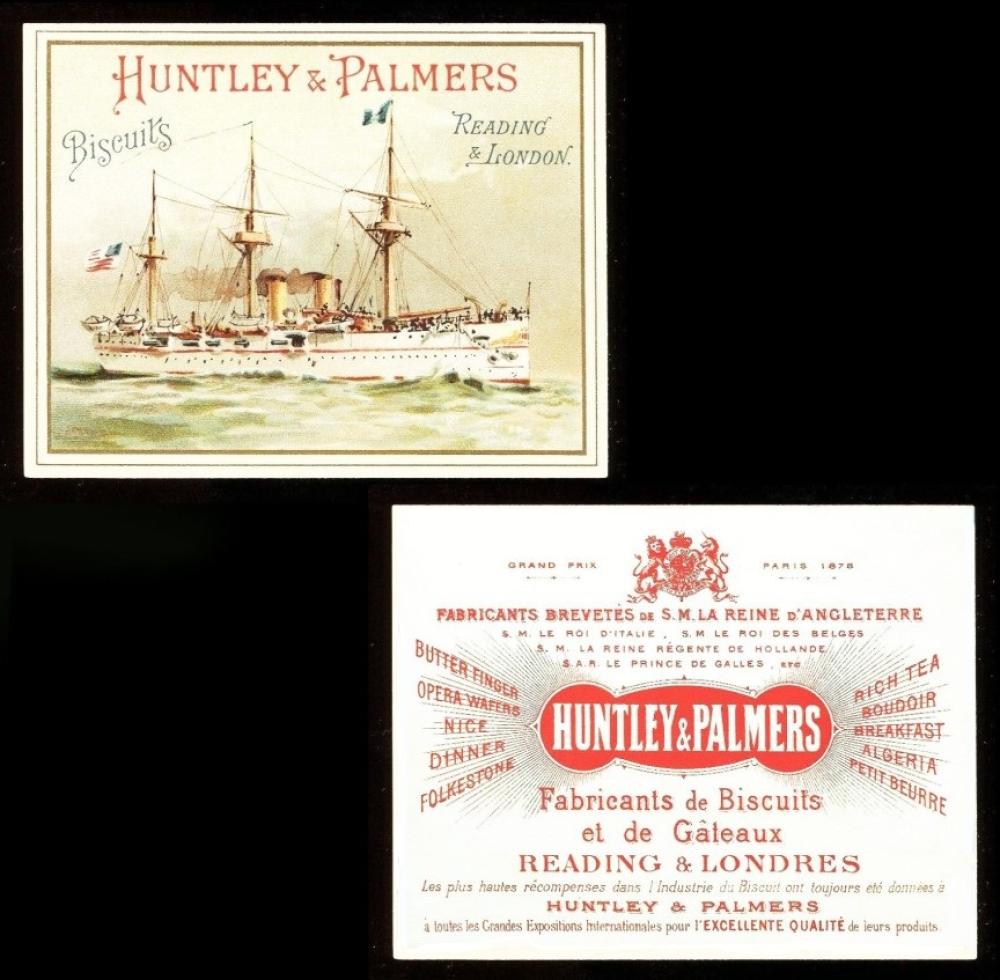
Huntley & Palmer [trade : UK] “Warships of All Nations” (1900) Un/12 – HUN-370 : HUT-20.b : HH-111
Today we are celebrating the dunkers and the purists, and those who do not believe that tea is tea without it. In fact with all this week`s tea cards, they are probably wondering why we have not opened a packet yet. What is it? Well it is National Biscuit Day. As far as favourites, probably every one of you would chant out a different name of the one you would most like to see as you opened the lid of your tin. I have a definite partiality for those old fashioned lemon puffs, which you will often thrillingly still find on the shelves in a post office that has found itself removed from a stand alone business premises and comfortably nestled within a grocery shop. You often get three packets of said lemon puffs for under a pound. This ought to make them last three times as long as one packet of normal biscuits, but somehow it never does, and by a long way as well. This is especially curious because biscuits were developed as a food which would last for a long time without being rendered inedible and would also survive the rigours of a long sea voyage. And there we have the reason why a lot of biscuits are really hard - for they go soft as they get old, so they are designed to start in an almost unbreakable state, and then once they are consumed they are of a more snappable, and easily digestible consistency.
By the way we have gone for this set as it will also see service on our Reading Branch Home Page, which currently does not have a featured card.
This turns out to be a really fascinating set though. Our British Trade Index, part one, starts us off really well, telling us in the header that Huntley & Palmer, of Reading and London, made biscuits, that their cards were issued about 1885 – 1910, that many series had backs in French for use on the Continent, and that all were large, or extra large in size. They were also as expansive with the set, describing it as :
WARSHIPS OF NATIONS (A). Size 111 x 67. Back (a) in English in blue (b) in French in red. No captions. Unnd. (12). Nine subjects as World Index Set E18-18, caption in that set shown in parentheses.
No.1 – In full sail to R. (The “Saboya”, Italy)
No.2 – In full sail to L. (The “Dom Pedro”, Portugal)
No.3 – At anchor, three masts (The “Olga”, Greece)
No.4 – At anchor, two masts
No.5 – Steaming to R., three masts, two funnels (The “Olympia”, America)
No.6 – Steaming to R., two masts, one funnel (The “Admiral Bauduin”, France)
No.7 – Steaming to R., two masts, two funnels, Italian flag
No.8 – Steaming to L., three masts, two funnels, German flag (The “Litis” (sic) Germany – error for “Iltis”).
No.9 – Steaming to L., three masts, two funnels, Spanish flag
No.10 – Steaming to R., two masts, two funnels, two white ensigns (The “Majestic”, England)
No.11 – Steaming to R., two masts, two funnels, Spanish flag (The “Reina Cristina”, Spain)
No.12 – Steaming to R., two masts, two funnels, white flag with red spot in centre (The “Baltimore”, America)
There is a bit of additional information in part three, which deals with the fact that additional variations have come to light, so reads :
a) back in English. Two different combinations of brand names on backs, as follows :
A. “Butter Finger” top brand at L/centre
B. “Opera Wafers” top brand at L/centreb) Back in French. Four different combinations of brand names on backs, as follows :
A. “Butter Finger” top brand at L/centre
B. “Opera Wafers” top brand at L/centre, top brand at R/centre
(a) “Folkestone” (b) “French Macaroons” (c) “Reception”
In part four there are more changes. Card number 9 turned out not to have the Spanish flag but the German one. And cards 10 and 12 were actually “Steaming to left, not right”. Even better, someone had found a copy of Conway`s “World’s Warships 1860 – 1906” and identified all the boats, as…
No.1 – “Zaragoza” (Mexican, launched 1891)
No.2 – “Vasco da Gama” (Portuguese, launched 1876)
No.3 – “Minin” (Russian, launched 1869. Probably sold to Greece and renamed the “Olga”) – though Olga is surely more of a Russian name than a Greek one?
No.4 – “Colossus” class. (Great Britain, launched 1882)
No.5 – “San Francisco” (U.S.A. launched 1889)
No.6 – “Hoche” (French, launched 1886)
No.7 – “Giovanni Bausan” (Italian, launched 1883)
No.8 – “Tegetthoff” (Austro-Hungarian, launched 1878)
No.9 – “Kaiser” class (German, launched 1874)
No.10 – “Majestic” class (Great Britain, launched 1894-96)
No.11 – “Pelayo” (Spanish, launched 1887)
No.12 – “Takasago” (Japanese, launched 1897)
Now, and I have to say sadly, almost none of this information is in our updated British Trade Index. The description is just
WARSHIPS (A). 111 x 87. Backs in blue, with top brand on left a) “Butter Fingers”, b) “Opera Wafers”. Also issued in French. Unnd. (12). See HH-111.
Of course due to this being a single volume, something had to be excised, and therefore the details of the French cards were lost. The HH-111 reference does take you to the separate handbook though, where you will find a list of the cards with the ship names in brackets. And since I have typed two lists today I may as well add the third, which reads :
HH-111. WARSHIPS. (A) Unnd. (12) Issued by Huntley & Palmers. See HUN-370.
The probable identity of the ships is shown in brackets.
No.1 – Full sail to right. 3 masts. 1 funnel. Flag red/green/white, Mexican. (Zaragoza)
No.2 – Full sail to left. 3 masts. 1 funnel. Flag green/white, Portuguese. (Vasco da Gama)
No.3 – At anchor, 3 masts, 1 funnel. Flag, green cross on white, Russian (Minin)
No.4 – At anchor, 2 masts, 1 funnel. Several flags, including White Ensign (Colossus)
No.5 – Steaming to right. White hull, 3 masts, 2 funnels. Rear flag red lines on white, blue/green square top right, United States (San Francisco)
No.6 – Steaming to right. 2 masts, 1 funnel, 2 rear flags, French (Hoche)
No.7 – Steaming to right. 2 masts, 2 funnels. 3 standing men visible. Flag red/white/green, Italian (Giovanni Bausan)
No.8 – Steaming to left, 3 masts, 2 funnels. White cloud above masts. Flag black cross on white, centre circle, Austro-Hungarian (Tegetthoff)
No.9 – Steaming to left. 3 masts, 2 funnels. Smoke cloud to right, another ship in right distance. Flag white background, red strips top & bottom, German (Kaiser)
No.10 – Steaming to left. 2 masts, 2 funnels, 2 White Ensigns (Majestic)
No.11 – Steaming to left. 2 masts, 2 funnels. Flag red & yellow, Spanish (Pelayo)
No.12 – Steaming to left. 2 masts, 2 funnels, rear flag white flag, red spot, Japan (Takasago)
Now don't think I have forgotten Set E18-18. This turns out to be a tobacco set, by The Egyptian Cigarettes Manufacturing Co. Shanghai, China, also issued in 1900. They are described as circulating English Language issues, about 1895 – 1905, but these cards were standard size, 68 x 36 m/m, and were similarly untitled. The description from our original World Tobacco Issues Index is simply as follows : "WARSHIPS (A). Back in dark blue. Unnd. (25). See X36/3.
This reference leads you to the Handbook to the World Tobacco Issues Index, RB.22, published in 1956. And, guess what, to another list. Above that it shows small black and white photos of the back, purely advertising, and a typical front. This is where it gets even more confusing, because it is titled on the top of that card, “The “Dom Pedro” – Portugal”. That means that it looks like the list in the original British Trade Index may have come from off this set, for, if you remember that said No.2 – In full sail to L. (The “Dom Pedro”, Portugal). However it does not explain how the updates seem to have rechristened this “Vasco da Gama”, or pretty much altered everything else. Anyway, the list of cards from The Egyptian Cigarettes Manufacturing Co. Shanghai, China set is as follows. It does number them but I have chosen to just add the names in alphabetical order.
Admiral Baudin – France
Aegir – Germany
Baltimore – America
Brandenburg – Germany
Camperdown – England
Castelfidardo – Italy
Charles Martel – France
Diadem – England
Deutschland – Germany
Dom Pedro – Portugal
Duilio – Italy
Gustave Zede – France
Litis (sic) Germany
Majestic – England
Marceau – France
New Ironsides – America
Olga – Greece
Olympia – America
Plongeur – France
Ramilies (sic) – England
Reina Cristina – Spain
Rochambeau – France
Saboya (sic) Italy
Tegethoff – Austria
Tonnerre – France
Moreover, when this set appears in our updated World Tobacco Issues Index as E320-900. it has added yet another complexity, for it now tells us there are two back colours, either (a) blue or (b) brown.
So therefore it is over to you! And if any of our maritime collectors have any comments on these lists, or can offer different identifications, do please get in touch with us.
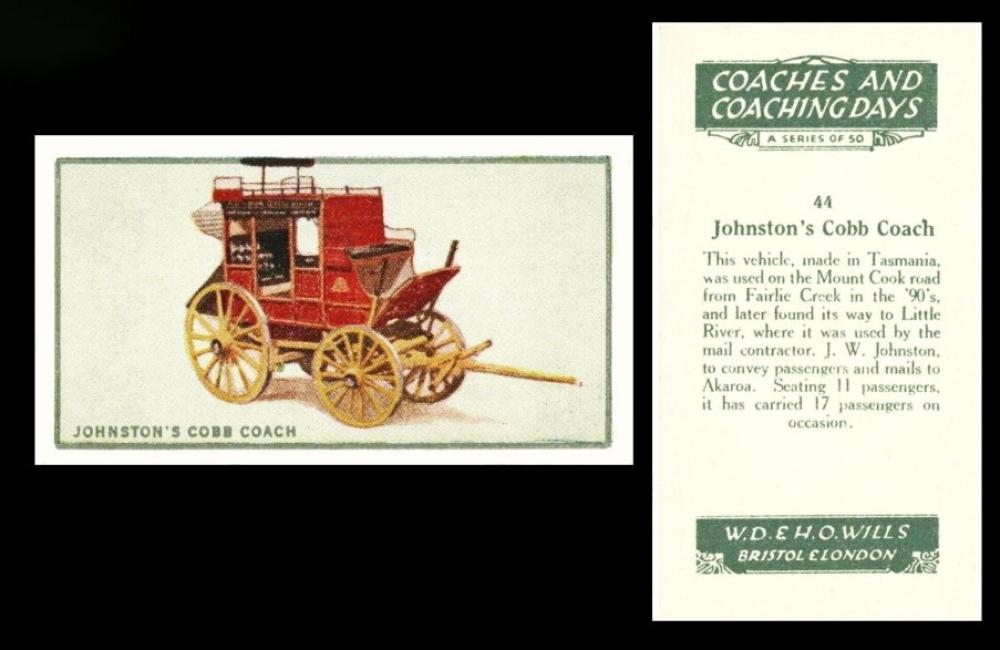
W.D. & H.O. Wills [tobacco : UK] "Coaches & Coaching Days" (1925) 44/50 - W675-636 : W62-442 : W/175
Rather a tenuous card link but it does have a fascinating tale. For today in 1899, a stagecoach was trundling along somewhere way out west when it was attacked and robbed, by a woman, Pearl Hart, or not, as she had been born Pearl Taylor, and she had picked up several husbands, or friends whose names she also casually used.
She was born in 1871, so she was was almost thirty when she robbed the stagecoach, in one of the last such events to have been recorded.
The Hart was actually from her first husband, who she had acquired when she was just sixteen. He was exciting, but carefree (the two so often do seem to go together) but does not seem to have been unfaithful. She was, several times, despite having two children, who would be left at home, or sent to her mother, whilst she went hither and yon with different men.
In 1893 husband and wife were back together and they travelled to the Chicago World`s Fair, He seems to have had an offer of employment there. She seems to have spent some of the time watching the Buffalo Bill`s Wild West Show, and this is often claimed to be how she got the idea to go and live there. She also met a new man, and as the fair closed, she ran off with him in a westerly direction.
The west was tough, and she had to work, and when that did not work out, as it frequently did not, to make money however she could. In 1899 she was in Arizona, working with a male friend who owned a ramshackle old mine. Eventually it was realised that the gold was not there, so she had got a job as a cook, which she did not like. The duo decided that the mine would be successful if they had more money, so, as you do, they decided to rob a stagecoach.
They approached and fired their guns and the coach stopped. Her accomplice stood and threatened to shoot anyone who did not hand over all their worldly goods and she took the money, guns, and anything else that was there, but curiously left the passengers with a dollar each. They then galloped away. After a decent interval the driver untacked one of his horses and rode back to town at speed to fetch the sheriff.
The sheriff got a band of men together and they started hunting for the robbers. At that time they were thought to be two men, as Pearl was wearing mans clothing and had cut her hair short. The hunt continued for just under a week then the pair were discovered, asleep and after a bit of a struggle, on her part, they were captured and taken to jail. As she was a woman, she was taken to a slightly more comfortable one, in which she received much attention from the press. And from where she escaped, a few months later, after a male accomplice had helped her make a hole in the wall to climb through. It is not reported that he went with her in the flight for freedom though. She was soon recaptured though, and went to trial, in which she was found not guilty for robbing the coach, but immediately rearrested because amongst the haul from it were letters, and this led to the charge, quite a serious one, of mail tampering. This led to a prison sentence.
Less than two years later her partner escaped and was never recaptured. However she seems not to have been too unhappy there, she was the only female resident and enjoyed the protection of the warden as well as the affection of the other men. And in 1902 she was released. There are rumours that she was pregnant, to the warden, but either she was and lost it, or it was a convenient untruth to set her free, who knows. The warden seems not to have appeared in her story again either.
Instead of settling down she went on a tour, telling of her exploits. And she did work, for a time, on Buffalo Bill`s Wild West Show. But in 1904 she was again arrested when stolen goods were found in the cigar store she was either working at or running, accounts vary. Nobody knows what happened after that. But rumour says she was let off, and again she got married. Maybe she married the judge this time.
Now I know this coach is not from America, but it is the same sort of coach as would have been used there. And this is a set I have not used before.
Our Wills reference book part four tells us that this set is :
175. 50 COACHES AND COACHING DAYS. Fronts printed by letterpress in colour. Backs in grey, with descriptive text. Issued in New Zealand, between 1925 - 30. Similar series issued by Dominion Tobacco Co. Ltd., Wellington.
The backs of the Dominion version are almost identical, except the bottom square at the bottom of the reverse says "DOMINION TOBACCO CO. LTD. / WELLINGTON" in two lines.
The entry in both our World Tobacco Issues Indexes is simply : COACHES AND COACHING DAYS. Sm. Nd. (50). See W/175 However the header for this sub-section, 5B. in the original, and 6B in the update, does tell us that they were “English Language Issues 1923-30. Issued chiefly in New Zealand, some series in Malaya, Malta, and elsewhere.”
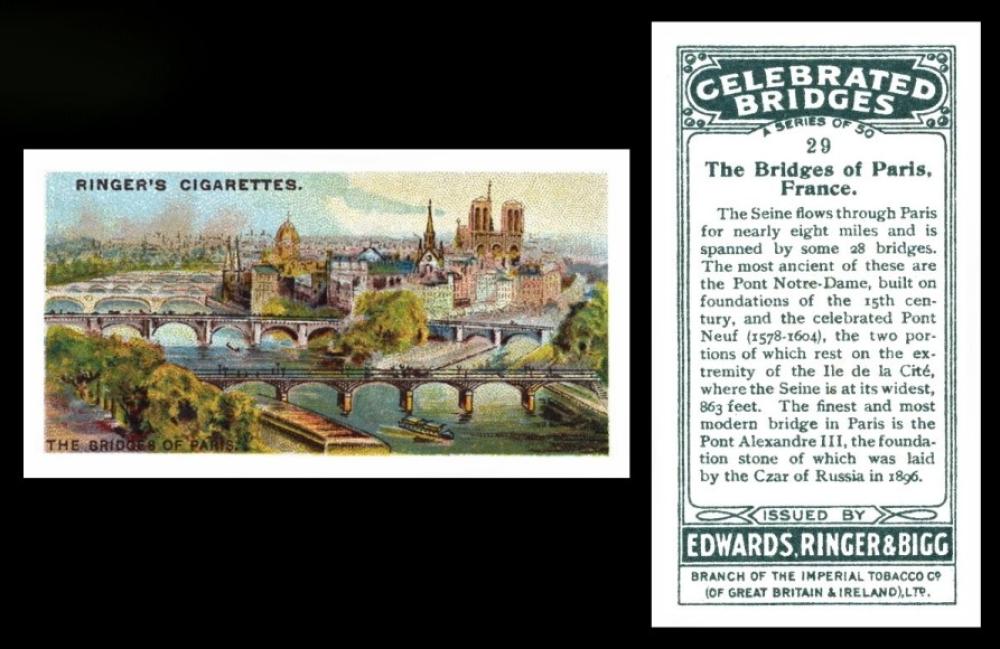
Edwards, Ringer & Bigg [tobacco : UK] "Celebrated Bridges" (1924) 29/50 - E14-31 : H.346
Taking you back to sixteenth century France now, and to today in 1578, when the foundation stone was laid on Pont Neuf in Paris.
In fact the name simply means New Bridge, and at that time it was indeed the newest bridge over the Seine. It was also new in design, for the others were all covered in, providing shops and housing. These have all now been replaced, but the name of ours remains.
It was actually because of those that this bridge was needed, for the traffic was too heavy to wind its way over the congested and narrow bridges, and it took too long to approach one, find it queuing, and have to divert further up or downstream, only to find the same there. I guess nothing really changes! So the merchants and hauliers got together and approached Henry II, and he said no, it was too costly. But somehow they got their way and today in 1578 the foundations and the first stone of the construction was laid, the latter by Henry III. There had been one change to the plans, as the original drawings showed a perfectly straight bridge, but the builders knew that to have a slight bend would make it more resistant to the currents which were forcibly diverted around the island that the pillars were to stand upon.
The description to this set in our original World Tobacco Issues Index was only : CELEBRATED BRIDGES. Sm. Nd. (50) See H.346. And H.346 merely listed the other issuers, W. & F. Faulkner and John Player.
Now I know this card has been used before but it says "Pont Neuf" on the back,so does anyone have the Faulkner version of this card they would like to send us as a scan so that we can swop it over?
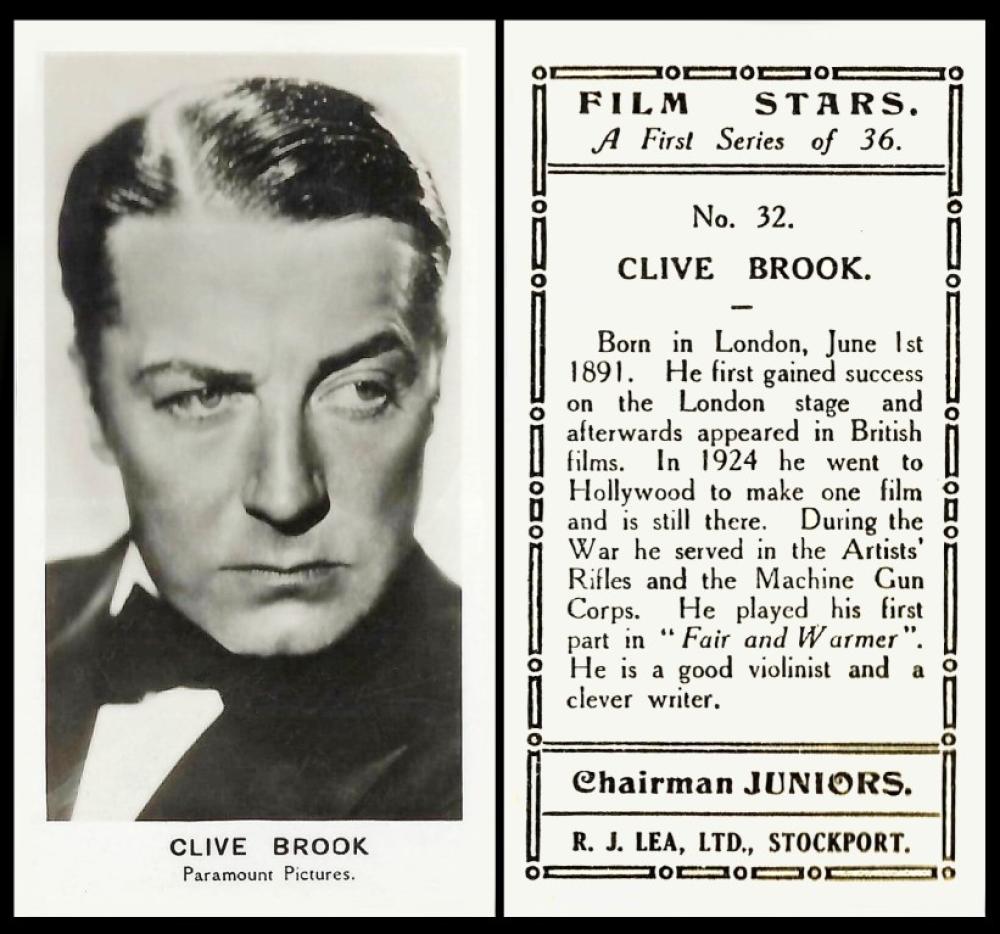
R. & J. Lea [tobacco : UK] “Film Stars” first series (1934) 32/36 – L250-825.1 : L26-34.1
Today, in 1887, Clifford Hardman Brook was born (though this card, and Wills "Cinema Stars" first series 3/25 say 1891). His father planned him to be a lawyer but finances prevented this.
Instead he became an insurance clerk, short story writer, and a journalist, which is why, as this card tells us, during the First World War he served in the Artists Rifles, and then the Machine Gun Corps. In fact he rose to be a Major in the Artists Rifles. And actually Wills "Cinema Stars" first series 3/25 says "he enlisted", rather than being conscripted.
His first appearance on stage came in 1918, Wills "Cinema Stars" first series 3/25 saying this was in a production called "The Harbury Pearls". Records say he moved to film the following year but the first film recorded is "Trent`s Last Case", a crime thriller released in 1920, so maybe it took an awfully long time to make, or be released.
In the same year he got married. Then he made a lot of movies, but nothing spectacular. In 1924 he was requested to go to Hollywood and make one film. As our card says he never left, except he did, because in the mid 1930s there was a very strange threat to kidnap his children, and he moved back to England.
In 1924 he also appeared on what is regarded as his first cigarette card, the Godfrey Phillips circular "Cinema Stars" - this mentions "Trent`s Last Case" too.
A lot of people seem to think that the Wills "Cinema Stars" first series was issued before that, it certainly looks older in design, but was not released until 1928. However it is rather a sought after card because on the front he is depicted as Sherlock Holmes, one of his great successes. He played the eponymous detective in three films, starting in 1929 with the Return of Sherlock Holmes.
After his return to England Clive Brook acted in films, and on stage and radio. He remained married until he died in 1974. His two children were both actors, but his son died in 2004.
No reference book is devoted to the sets issued by Lea, so we only have the World Tobacco Issues Indexes, which describe it as :
FILM STARS. Sm. 65 x 35. Black and white photos. Special albums issued.
1. “A First Series of 36”. Nd. 1/36. (36)
2. “A Second Series of 36”. Nd. 37-72. (36)
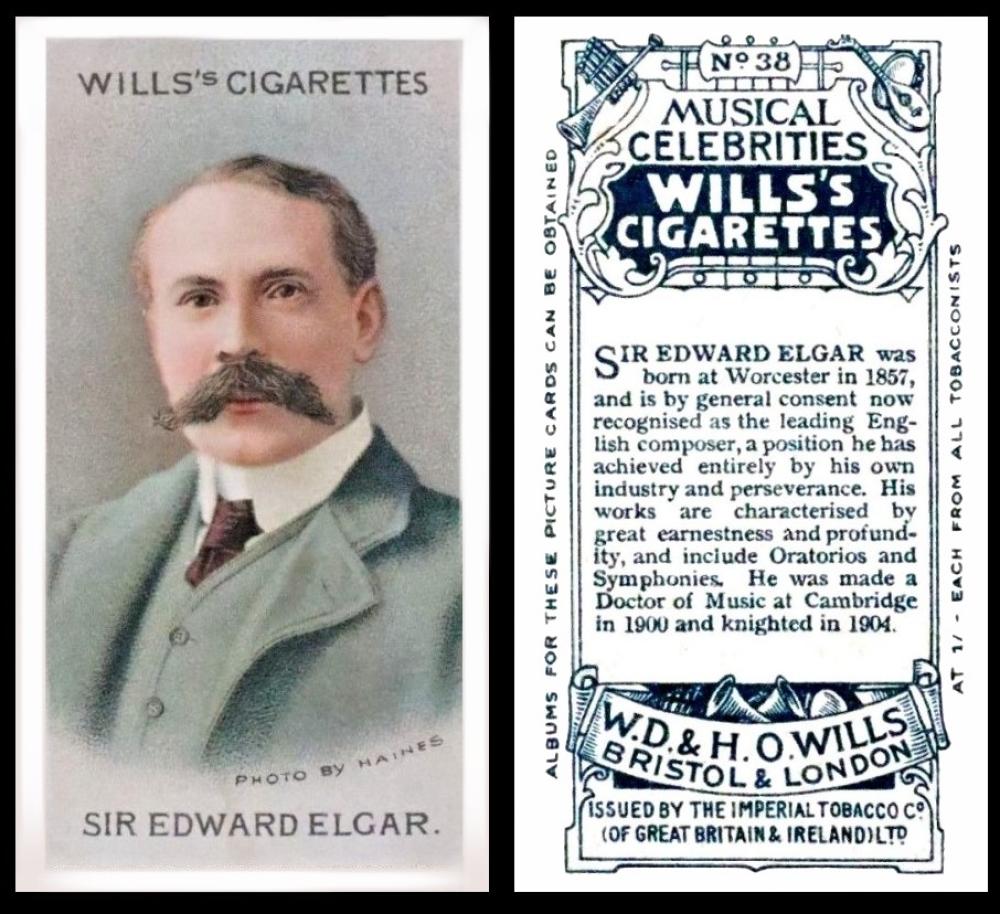
W.D. & H.O. Wills [tobacco : UK] "Musical Celebrities" first series (November 1912) 38/50 – W675-123 : W62-90.1 : W/83
And so let us send you into the next section with a little light music, provided by birthday boy of the day Edward Elgar.
This card tells us he was born in Worcester in 1857, and that he is "by general consent now recognised as the leading English Composer... he was made a Doctor of Music at Cambridge in 1900, and knighted in 1904"
Today we look at him as being typically English too, and perhaps a bit old fashioned, but at the time he was, daringly, using themes and even samples, from European works, which at the time we had no access to, but which he had heard on his travels there in the 1880s.
He always felt he was not English enough, and tried desperately to fit in, but seems to have had an inferiority complex about everything; his parentage, of a piano tuner and a farmer`s daughter, his religion, even the fact that he taught himself to read and write music rather than go to a specialist college. Perhaps that was why he was so keen to marry his wife, for she fitted in, and she was the Daughter of the Regiment too.
It was really the success of the Enigma Variations that set him moving forward and released some of his tensions. They were first performed in 1899, to popular acclaim.
After his knighthood he moved to a huge house in Hereford, and this seemed to make him at last feel that he belonged. In fact in 1905 he was asked if he would like to become Mayor, but he refused. He did not enjoy the limelight, even at a distance, and probably felt that to be famous in his immediate area would be too much of a bad thing. He was also prone to illnesses and neuroses which led to him retreating out of view and not being able to do anything at all.
In the 1920s, he was created Master of the Kings Musick, and in this capacity penned several stirring works to be played at the British Empire Exhibition at Wembley, some being used as part of the Stadium events. In fact he conducted the orchestra during one of those events, the Pageant of Empire, in July 1924. He intended to also use a specially composed work called the Empire March, but for some reason this was never performed, the decision was simply made to use the Imperial March instead, which had been written for Queen Victoria`s Diamond Jubilee.
Elgar died in February 1934 at the age of seventy-six and was buried in Malvern next to his wife, who had died in 1920.
Our original Wills reference book part three tells us this set is :
83. MUSICAL CELEBRITIES. Two series of 50. Fronts lithographed in colour; backs in grey with descriptive text. Home issues : -
A. Series of 50. Issued 1912.
B. Second Series of 50. Issued 1916. Eight cards of the Second Series, as originally printed, depicted musicians who, as a result of the outbreak of war in 1914, became enemy subjects. These cards were replaced, but a few at least of the original cards got into circulation. The eight substituted cards are easily recognised as the board is noticeably whiter and there is a full stop at the end of the Album Clause.
The original cards, and their replacements, are :
10. Sir Charles Halle (new card Boccherini)
19. Lady Halle (Thomas Moore)
20. Arthur Nikisch (Verdi)
25. Felix Weingartner (Sir J. Stainer)
26. Hugo Becker (Massenet)
37. Fritz Kreisler (Moritz Mozkowski)
46. Elena Gerhardt (Madame C. Chaminade)
47. Wilhelm Backhaus (Dr. A. Somervell)
The entry in both versions of our World Tobacco Issues Index is smaller, simply :
MUSICAL CELEBRITIES. Sm. Nd. See W/83.
1. First 50 subjects.
2. “Second Series”. Nd. 1/50 with two subjects for Nos. 10, 19, 20, 25, 26, 37, 46 and 47. (58)
Now there is something else rather curious about this set, which is that, for some reason, cards 3, 6 , 8, 22, 33, 39 and 40 of this second series are said to “bear a back design differing slightly from the other cards in the series”. We asked if anyone could explain this and we were rewarded with not only the information, thanks to keen reader Andrew Walters, but some scans. Now before we explain further, have a look yourself and see if you can "spot the difference" ...
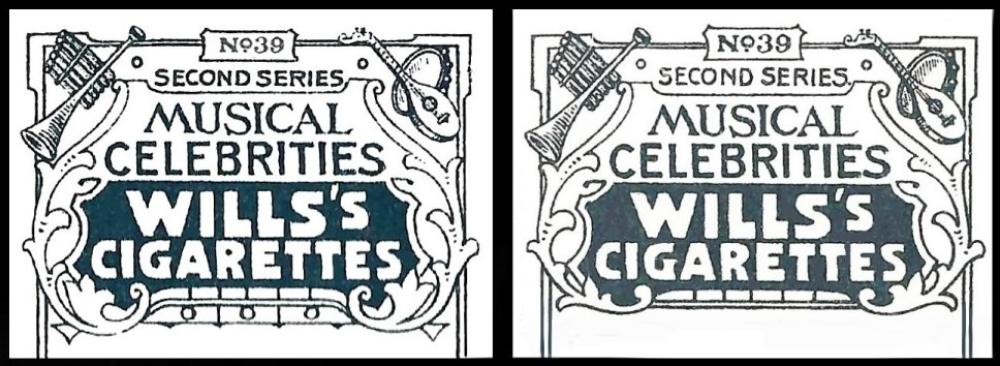
He also tells us that in addition to the 7 cards listed above, card number 25 (of Felix Weingartner) also has the different back design.
In case you are still stumped, the main differences are :
1. a dot, or full stop, after SECOND SERIES on second card
2. under cigarettes the row of what look like piano keys are curved at the end, or straight
3. the bar below these keys is also curved at the end or straight
4. below that bar there is a further line of three boxes with central circles.
Now in case you were wondering, the first set of "Musical Celebrities" have the additional row of boxes on the backs, so it is probable that this design was the original on the second series as well. But why did they not just leave it as a curved line, and remove the lower boxes, rather than redrawing the top row and the bar? And we do not yet know why the design was changed.
Now if you have some time on your hands, nip along to the internet auction of your choice and you will find that a lot of the complete sets being offered have backs of both formats amongst them. You may also find that your own set has. However it is entirely up to you whether you decide to try and make up two sets, or whether you just enjoy the fact that you can now show off your cards and also tell of this interesting story. I cannot find any catalogue that lists the set as either back A or back B so the truth is that it is entirely up to you.
This week's Cards of the Day...
celebrated the fact that it was National Tea Day on the 21st of this month. Which I wrote down as the 24th, and did not find out until the 22nd - but never mind, because in fact (as well as extraordinarily luckily), the whole month of June is iced tea month - which used to be a particularly American drink, but now that we get long hot summers too maybe we should give it another tasting. Actually our first card was bang on target, we just drifted a bit midweek. But nothing here is set in stone and it may one day be an entire week devoted to the delights of iced tea, with the odd men out being relocated to other parts.
So our first card of the day for this week was really apt:
Saturday, 20th May 2023
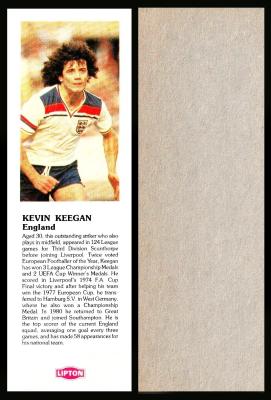
So here was your starter clue to this week`s theme, which was amazingly bang on for iced tea month.
And we started with a bit of a puzzler in many ways, because though the set is listed under Liptons Tea Ltd, the write up says that it is an anonymous issue, but you only have to look at the bottom of the front to see that large Lipton logo in bright red. So that makes me wonder if either the first card seen, which formed the basis of the description, was trimmed, and that sadly often happens when the cards are longer than usual - or there was an anonymous set without the red logo. Anyone know?
Now on Saturday I also prophesied that the plain back might mean it was a package issue, printed on the carton to be cut out at home? My suspicions aroused by the surface of the reverse being rather rougher than I thought it would be if it had been a card inserted inside the packet.
And that could also explain why it was plain backed, because to get a back and a front to line up exactly in the right place is quite a task.
It is definitely one that defeats me, who cannot get even get the front and back facing the same way up if I print on both sides for a letter.
By the way the reference to HL-39 takes you to the Handbook, where it lists the footballers in the set, because they are not numbered. If I cannot find a link online to this info I will scan that section for the newsletter.
Sunday, 21st May 2023

This clue referred to the "cup", out of which all kinds of tea is drunk. So another kind of okay for iced tea.
I was not sure why our cup was named specifically for Aldershot, unless it was a local competition, and there were certainly no shortage of military men in Aldershot enough to make up several football teams and a fairly substantial league. I have had a look into this and found details on facebook of The Aldershot Divisional Football Association Senior Cup competition which appears to fit, and the trophy also seems similar, though the plinth must have been replaced or heightened to take more shields. It also has a connection with the Duke of Connaught too. However my early hunts have shown me that this competition was first won in 1895 when the Highland Light Infantry beat the First Wiltshire Regiment. But maybe the cup was made during their tenure so that it may be presented to the next winner, and, with the plinth in place, forever record the name of the first and all future winners?
As for the card chat, lets start with our Reference Book RB.5, listing the Issues of Abdulla, Adkin and Anstie. This was published in 1943, right in the middle of the Second World War. The sets are not numbered but I have worked the numbering out and made this Ad/15. I may be wrong there, so just let me know if you count your copy and get a different number.
The description from this book is :
1914 – 30 Sporting Trophies (titled series). Size 2 5/8” x 1 7/16”. Numbered 1-30. Fronts lithographed in blue and black with green and brown background and darker green margins “Adkin`s Cigarettes” – trophy in gold on silver – description underneath. Backs. “A series – number – of thirty – Sporting Cups and – Trophies – Description of trophy – Adkin & Sons – Branch of the Imperial - Tobacco Co. (of Great Britain & Ireland) Ltd.
I am intrigued why this booklet calls the set as “Sporting Trophies” (titled series) rather than the correct “Sporting Cups and Trophies”. If they had called it “Sporting Cups” you could have excused the cataloguer for not seeing, or not adding in the second line, but they took the trophies from the end and omitted the cups entirely.
In both our World Tobacco Issue Indexes this set appears as just : "SPORTING CUPS & TROPHIES. Sm. Nd. (30)". The only difference is in the code, which changes from A12-12 in the original to A165-660 in the update; and really demonstrates just how many discoveries our hobby has seen in those intervening years.
Monday, 22nd May 2023
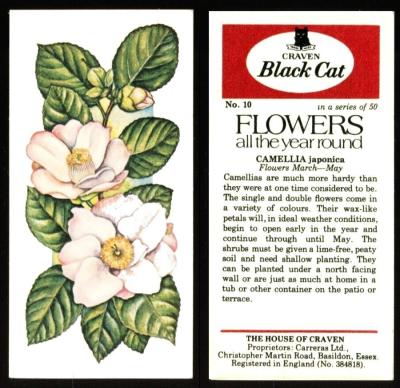
And so to our final clue, the Camellia.
The link here is that it is from a variety of this plant which tea actually comes - our plant being Camellia Japonica and the tea one being Camellia Sinensis. So we got away with the link to iced tea here as well.
The Japonica suffix simply means that it originated in Japan, where it was much prized, and specimens can still be seen around the Emperor`s Palace. It is a beautiful plant, and often, but not always, has many petals per bloom.
The Sinensis suffix means the tea comes from China, India, or Cambodia. The word "Sinensis" comes from "Sino" which is a prefix meaning relating to China. Its flower is more likely to have just a few petals, though the tea comes from the leaves and leaf buds, not the flowers, so you can harvest away and still enjoy the flowers. Making the tea is quite specialised, for the buds and young leaves, which contain more chlorophyll, make the "green" tea, and the larger older leaves brew up to be darker, so they make either Oolong or "black" tea.
Now there is only one code because this set was issued twenty one years after our original World Tobacco Issues Index. And sadly the only description in the modern version is "FLOWERS ALL THE YEAR ROUND. Nd. (50)". Though at the top of the header for those sets it does tell us that they were issued between 1976 and 1980, and measure 70 x 35 m/m, so slightly longer and slightly shorter than the standard size of a card.
They also all had special albums, but they were of a very different type to the normal stapled ones, having a kind of plastic binder strip.
Tuesday, 23rd May 2023
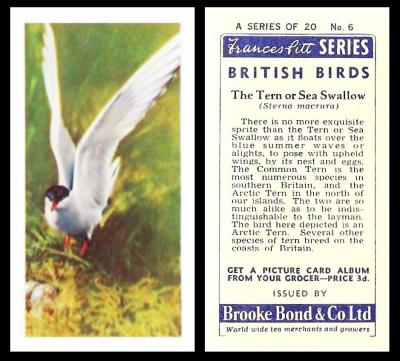
So here we have the first ever Brooke Bond set. This is because at the time this was scheduled to go on I was still working on the the theme of it just being standard tea. But guess what, in India Red Label Tea is top of the list for making a brew called Masala Chai, and this is often served as iced, at which time it is liberally spiced with cardamom, cinnamon and cloves, and sometimes ginger depending on whether that is locally grown. So guess that is another big tick for iced tea week!
Now some collectors of really early cards may think this is incorrect, but there was a reason why I said "set". For in the 1890s Brooke Bond issued advertising cards in several designs, most of which show at least one Chinese person, and say "Congou Tea". This is actually a black tea from China, and it was one of the most popular sort to be imported, in fact it provided the base of the original English Breakfast Tea, though as we have already found out the black tea is less prized in China and comes from the older leaves, not the fresh young green ones. As for the name Congou there are many theories - some say it comes from the Chinese word Gongfu, meaning skill, or taking care in doing things correctly, in learning a craft. This was anglicised, rather mistakenly, into being the name of the Martial Art, Kung Fu, rather than the skill and training it took to be able to perform it correctly. .
At one time it was thought that all these advertisement cards gave the address of 29 Market Street, Manchester, (which is now an EE mobile phone shop) but more recently (just in time to appear in the vintage part four) one was unearthed that says 11 Boar Lane, Leeds (for a long time this was a photographers, but now that too is a phone repair shop). I do not have any of these early cards, but if there are some in your collection and you think it might be fun to show them off here, please send us a scan or clear photo of the front and back - the email being webmaster@card-world.co.uk
Now our set was issued in 1954, and it is recorded in our original British Trade Index as being "BRITISH BIRDS FRANCES PITT SERIES. Sm. Nd. (20) B.1 see D.231".
Checking up shows that the set was also issued by Musgrave Brothers of Cork, and also as their first set of cards, but later, not until 1960. The Irish cards are a slightly different size, at 68 x 36 m/m as opposed to our 68 x 42 m/m.
Curiously, even at the height of the Brooke Bond reprinting, this set was never re-issued with a black back. Does anyone know why?
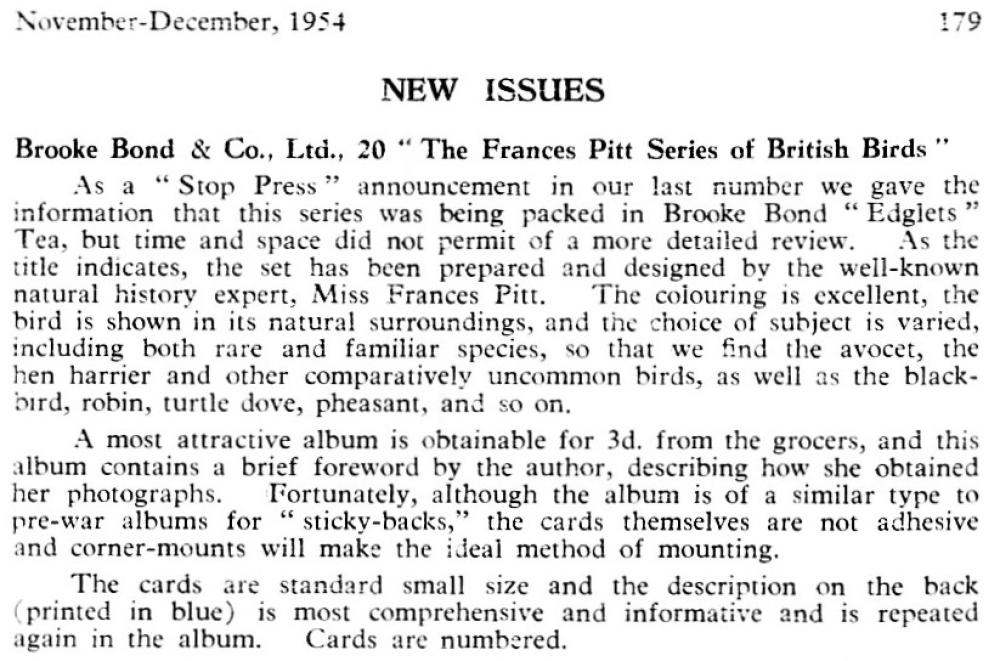
Wednesday, 24th May 2023
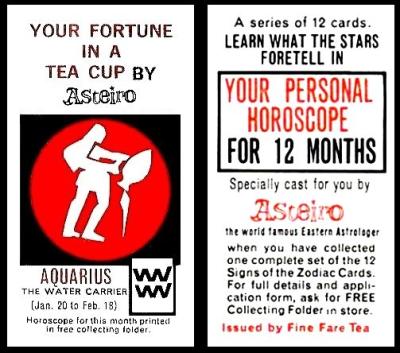
This is an interesting set because of its links to an astrologer, palmist, and yoga master, who called himself "Ceylon's World-Famed Seer". He was actually called Cyrus D. F. Abayakoon, "Asteiro" being his trading name. And I suppose I could get away with trying to convince you all that it was pronounced "Ice-Tea-Ro"...?
Now he was born in 1912, and in Ceylon, and in the 1960s he was based in Fulham, South West London. He was just a simple astrologer until he had a vision, and predicted Gandhi`s assassination in 1948. However it was his prediction of President Kennedy`s assassination in 1963 that really brought his name into the public eye, and probably led to this set.
This appears in both our vintage and modern British Trade Index, and under "F" for "Fine Fare", even though it is clearly stated that the main issuing company was Allied Bakeries. There is some additional information needed here, because Allied Bakeries started out when one man, from a bakery background, bought out several large bakers and their goodwill. Then, in 1963, they bought the supermarket chain of Fine Fare. Obviously they retained some of the products, hence Fine Fare Tea. The company is now known as Associated British Foods, and it also owns Ovaltine and Twinings Tea.
The original British Trade Index listing, in book two out of four, is :
SIGNS OF THE ZODIAC CARDS. Sm. 68 x 35. Black and brown, headed "Your Fortune in a Tea Cup". Unnd. (12) Signs of the Zodiac. Folder issued.
Now I am not sure where that title comes from, for the front clearly says "Your Fortune in a Tea Cup". In fact the entry in our updated two volume British Trade Index the description says :
YOUR FORTUNE IN A TEA CUP. 1965.. Signs of the Zodiac cards. 68 x 35. Black and brown. Unnd. (12) Signs of the Zodiac. Folder issued.
In both of these it states that the colours are `black and brown`, but this is not quite right, for the cards are all different, the fronts and backs having coloured wording in either red, green, pink, orange, purple or blue.
Also a bit more about the folder, for it was not just an empty folder in which to stick the cards, apparently you had to collect the cards and send them back with some personal details about your birth, and in exchange you would receive a horoscope drawn up for you by Asteiro. So technically the "Your Fortune in a Tea Cup" was not a way to tell fortunes by divination and by the shape of the symbols that the leaves created inside of the cup, it was instead that by putting this tea in your cup you would receive your fortune, foretold.
With my tarot hat on, I am really not sure why the word `fortune` came to be connected with horoscopes or with telling your future in any way, for not every card represents a fortune, or even money at all, most are just guidance as to what it is thought may lie in store for you in the next stage of your life. And I know, some people do not believe that the turn of a random card can suggest anything at all. Yet often if you are trapped in a dilemma, a card will pop up that seems to suggest a way forward to your fevered mind, and nudges you gently into action.
Thursday, 25th May 2023
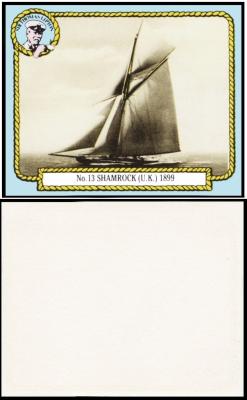
This set is quite a scarce one, maybe because the cards were printed on the packets, just like our earlier Lipton`s set. It comprises 24 cards, all yachts, and they were a selection of the vessels that fought for the Americas Cup, starting in 1851 with No.1 ( America), and ending in 1983, the year of issue, with No.24 (Australia II), which was the first ever Australian winner.
Card 3 shows the actual cup, which started out being called The Hundred Guinea Cup. This was the prize for a race, organised by the Royal Yacht Squadron of Great Britain, right around the circumference of the Isle of Wight. The winner was the schooner on card No.1, The America, which had come from New York, and in her honour the cup started to be referred to as "America`s Cup". And for some reason the name stuck fast.
Each card ought to measure 60 x 50 m/m but note the black border as this is sometimes removed, often quite innocently because when they were first cut off the packaging that particular collector thought the cards looked better without it.
I managed to accidentally find this set in our Australian and New Zealand Index, part two, RB.33, published in 1993. So it now has a card code. It also now has a proper standardized title, though the cards were not titled in themselves. And the listing in that book is :
America`s Cup Heritage (A) 60 x 50.
Package designs "The America`s Cup" at no.3, other numbers yacht contestants. Nd. (24)
Now our card is The Shamrock, Lipton`s own vessel, which you can also see on other cards -
-
Carreras "Notable Ships" ( 25/25)
-
Lambert & Butler "International Yachts since 1871" (1902)18/20
-
Ogden's Cigarettes "Yachts & Motor Boats" (1930) 38/50 and 39/50
-
Godfrey Phillips "Speed Champions" (1930), 25/30
and if you know of others do tell us!
Friday, 26th May 2023
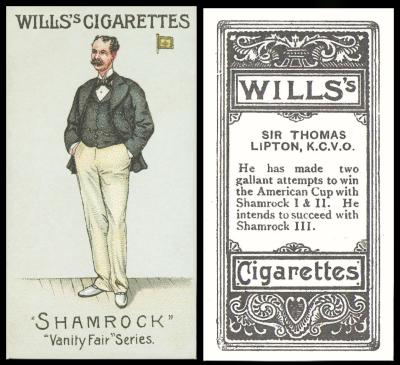
This card shows Lipton himself, though, as is customary for these cartoons, it does not call him by name, it calls him "Shamrock" - after his yacht. And note the tiny flag in the top right hand corner, which contains a shamrock too.
The back text mentions the fact that he is already on Shamrock III. Now this third version was designed by William Fife and built in Scotland, launching in March 1903. It was again an America`s Cup contender, entered by The Royal Ulster Yacht Club for the 1903 race but lost to the New York Yacht Club`s "Reliance" in every race. It only ever sailed again as almost a pacer for Shamrock IV, and was scrapped once those trials were through.
This may be leading you to question the given date of May 1902 for this set, but if you look at the text on the card it does not appear that Shamrock III had done a lot, if any, sailing, just that "He intends to succeed with Shamrock III".
Now there were three versions of this one set, and we have a home page which details them all with our Card of the Day for the 11th of May, 2025. This page only details the unnumbered set, though it does include any important information relevant to this from the other printings.
It first appears in our Wills reference book part two, or, more correctly, "RB.11 – The Cigarette Card Issues of W.D. & H.O. Wills Part I (revised) and Part II", published in 1948. The description includes all three versions, and gives the cards of the third, unnumbered set in alphabetical order of the card titles, but it also numbers them, very misleadingly, and so I have altered that to show them as bullets. The full description, altered, therefore reads :
- 31. "VANITY FAIR" SERIES. The name of this series was taken from a popular Victorian Society periodical [called] "Vanity Fair" which published a great many cartoons of notabilities, and the cards are reproductions of a suitable selection. The caricatures were usually accompanied by racy biographical sketches, and from these most of the card texts were extracted. The cartoonist was "Spy", and his self portrait appears in Series 2, card No.42
Fronts lithographed in colour on stone coloured background. Backs in grey, with texts.
The records of Wills show the issue date as May 1902. Printed by Stewart & Wolf, Germany. There are three series, each of 50 cards.
C) "Vanity Fair" Series. Unnumbered. This series consists of 37 cards from the first, 6 cards from the 2nd, with 7 new titles, as listed below ; -- "A Flannelled Fighter" (2nd, No.27)
- "An Admiral of the Fleet" (a new title)
- "A Retired Leader" (1st, No.23)
- "Aubrey Tanqueray" (2nd, No.26)
- "Australia" (a new title)
- "Birdseye" (1st, No.10)
- "Bobs" (1st, No.36)
- "Canada" (1st, No.20)
- "Canterbury" (a new title)
- "C.I.V." (1st, No.44)
- "Dick" (1st, No.40)
- "Dover and War" (1st, No.39)
- Dr. Jim" (2nd, No.16)
- "Dublin University" (2nd, No.22)
- "Easy Execution" (1st, No.29)
- "Fair, if not Beautiful" (1st, No.42)
- "Forbie" (1st, No.13)
- "Frank" (a new title)
- "From the Army to the Church" (1st, No.4)
- "From the Old Bailey" (1st, No.3)
- "Hard Head" (2nd, No.43)
- "High Commissioner" (1st, No.18)
- "Jacky" (new title)
- "Khartoum" (1st, No.22)
- "Ladysmith" (1st, No.35)
- "Little Bo Peep" (1st, No.46)
- "London" (1st, No.47)
- "Mafeking" (1st, No.37)
- "Mr. Speaker" (1st, No.15)
- "Our Soldier Prince" (1st, No.2)
- "Oxford Athletics" (1st, No.11)
- "Partnership" (1st, No.1)
- "Peking" (a new title)
- "P.R.A." (1st, No.17)
- "Ranji" (1st, No.21)
- "Redrag" (1st, No.30)
- "Sammy" (1st, No.6)
- "Self Reliant" (a new title)
- "Shamrock" (1st, No.50)
- "Smith`s Leading Cases" (1st, No.9)
- "Thanet" (1st, No.31)
- "The Colonies" (1st, No.45)
- "The Commercial Traveller" (1st, No.25)
- "The Croucher" (1st, No.49)
- "The New French President" (1st, No.24)
- "The Opposition" (1st, No.26)
- "United States Embassy"
Our original World Tobacco Issues Index lists these cards under Wills section 1.E, for "Issues 1898 - 1902 inscribed "Wills`s Cigarettes". Cards without the full name of firm" :
- “VANITY FAIR” SERIES. Sm. 68 x 36. See W/31 ... W62-58
3. Unnumbered. (50)
This means that without the original Wills reference book RB.11, which by then were in short supply, you would have no idea of the make-up of the unnumbered set. This is almost certainly one of the many reasons why the decision was made to reprint them all in one hard back volume.
In our updated version of the World Tobacco Issues Index, this has been partially restored, and the text there, still under Wills section 1.E, for "Issues 1898 - 1902 inscribed "Wills`s Cigarettes". Cards without the full name of firm", reads :
- “VANITY FAIR” SERIES. Sm. 68 x 36. See W/31 ... W675-083
3. Unnumbered. (50). 43 subjects from the above two series, 7 new subjects.
well not so bad, I ought to be able to upload this in a minute and it will be just after midnight. And I will enjoy my day off all the more tomorrow. Sometimes during what I shall call "disastrous weeks" I may upload at midnight but then fossick on interminably until the light begins to appear through the window and I realise I have not yet had any sleep at all.
Some may feel mine a lonely existence, but I much enjoy the sense of being the only one alive in the world, with a whole day to do whatever I so desire. That bit never happens though.
